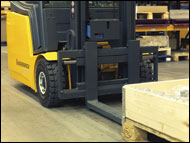 Jungheinrich has developed two new automated pallet scanning and identification solutions that are an integral part of the forklift truck and bring considerable time and efficiency advantages to the supply chain.
Jungheinrich has developed two new automated pallet scanning and identification solutions that are an integral part of the forklift truck and bring considerable time and efficiency advantages to the supply chain.
Single pallet scanning
Until now, the most common method for identifying a single pallet has involved scanning the pallet’s barcode using a hand-held scanner operated by the warehouse worker or forklift operator. Now Jungheinrich has devised a system that enables the scanning device to be fitted at the back of the lift truck’s fork assembly. In operation, the driver simply enters the truck’s fork into the target pallet as normal and the scanner automatically records the ID barcode located on the pallet load.
Once the barcode has been successfully scanned, the scanner automatically switches off for safety reasons. The information on the barcode is relayed to the warehouse management system and a pallet location is allocated within the racking. The truck operator then delivers the load to the specified destination and puts the pallet away before scanning the pallet location ID to confirm that the pallet is in the proper place. Once the WMS has confirmed that the pallet is where it should be, the forklift operator receives his next set of instructions via his on-board terminal. If, for some reason, the operator has placed the pallet in the wrong location, the WMS will not transmit further instructions – alerting the operator to his error. The system works in the same way when pallet loads are to be moved within the warehouse racking system.
The new fork-based scanning process not only results in significant time savings compared with manual scanning, but also reduces the forklift driver’s workload and ensures low picking error rates.
While Jungheinrich offers its own warehouse management system, the new scanning system is compatible with most leading WMS brands.
“Traditional pallet scanning methods, where the truck operator uses a hand held device, take time and can be difficult – particularly when the operator is trying to scan through the mast,” says Steve Richmond, general manager of Jungheinrich UK Ltd’s systems and projects division. “There are also ergonomic implications if the truck driver is forced to twist and turn his body in order to get a good ‘shot’ at the barcode with his terminal. Our new systems remove these issues.”
Identifying multiple pallet loads
In applications where multiple pallets are handled, Jungheinrich has devised a similar fork-based system that uses RFID technology and scanning antennae integrated within the forks to scan several pallets at once automatically.
All pallets are fitted with their own built-in RFID transponder that contains the pallet ID. The forklift operator drives into the pallets and the antennae within the forks reads the ID of the pallets and relays the information to the warehouse management system. All the pallets are verified and recorded simultaneously and a put-away location is allocated. This information is sent back to the truck terminal. Once the operator has delivered the pallets to the correct location, the location ID is scanned and the system confirms that the pallet is in the right place, before the operator is allowed to move on to his next task.
“The ability to identify multiple pallets at the same time, using RFID technology in a single scanning step, is a significant benefit,” says Steve Richmond. “It saves time compared to manual scanning and improves the ergonomics for the driver. It also improves process safety and operational efficiency by reducing put-away errors.”
“At the moment, this new system is at its most productive in closed pallet systems but RFID will become more and more widely used for pallet identification purposes and we believe it is only a matter of time before this technology is more widely adopted.”
The forklift becomes a logistics unit
By effectively combining the truck and the data capture terminal, Jungheinrich feel they have developed a solution that turns the forklift into a logistics unit. “The truck becomes the communication centre for processing material and information between the warehouse management system and the warehouse floor,” says Steve Richmond. “By integrating the forklift truck into the information process we can increase efficiency and safety, reduce costs and energy consumption and improve on truck ergonomics for the operator.
Steve Richmond continues: “Within any warehouse operation a lot of time is wasted searching for pallets and at sites where hand held data capture devices are used, the time taken by the operator to scan the pallet manually is unproductive. The manual scanning process is inconvenient and can also be ergonomically harmful to the operator. Our tests have shown that our automatic scanning process saves so much time that the return on the investment is very rapid indeed.
“It could be argued that forklift trucks are approaching the point where they cannot be safely made to travel any faster or lift the load any more quickly without contravening health and safety requirements, therefore future supply chain efficiencies are likely to be made by optimising the truck’s on-board intelligence systems and integrating the truck into the supply chain information process. We believe that our new automatic scanning systems represent a significant step forward in truck intelligence.”
The new fork-based scanning systems can be incorporated into all of the trucks in the Jungheinrich range.
Jungheinrich UK Ltd
www.jungheinrich.co.uk




Comments are closed.